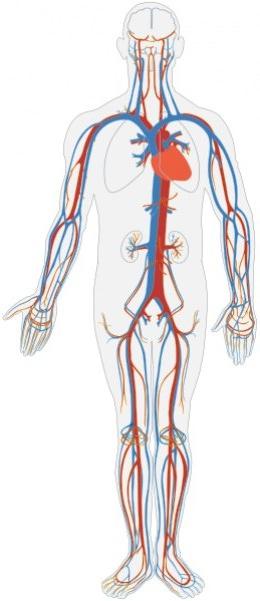Blood is a component of the internal environment of the human body and the main transport system, since not only its own, but also the cells of the immune system function in it. Plasma proteins transfer hormones, nutrients and oxygen to all tissues, and also maintain temperature homeostasis.

In this regard, the circulatory system of a person is distinguished, or rather, the functional system, which includes the heart with the main vessels, arteries and veins of medium and small orders, as well as the capillaries that make up the microvasculature. All of them have their own unique structure and regulatory mechanisms. Since the heart is four-chambered in higher animals , it is customary to distinguish between large and small circles of human blood circulation. In addition, cerebral and cardiac are also distinguished, since they have some features. The first discovery of the general laws of this system was made by W. Harvey in the 1st half of the 17th century, and subsequently the data was replenished as knowledge on anatomy and physiology was enriched, explaining the hemodynamic and rheological properties of blood, as well as the subtle mechanisms of its movement through the vessels.
Structure
Circles of a person’s blood circulation could not exist without the central organ of this system - the heart. This is a hollow, or rather, chamber, muscle organ, which, by the force of its contractions, carries out, in fact, the dynamics of blood flow. And in the future, the vessels themselves, or rather, their muscle wall, contribute to this.
A large circle of blood circulation in humans provides trophism and respiration of almost the entire body: the trunk, limbs and internal organs. Usually, the left common
carotid artery (aa.carotis communis) and the brachiocephalic trunk (truncus brachiocephalicus), which provide nutrition to the brain, usually extend from the aortic arch. The other branches of this great vessel, which begins in the left ventricle, are the two
subclavian arteries (aa.subclavia dexter et sinister), and then the axillary (aa.axillaris) and brachial (aa.brachialis), which supply blood to the hands. The organs of the abdominal cavity, pelvis, and lower extremities receive trophism through the abdominal part of the aorta. The systemic blood flow to the lower and upper vena cava flows into the right atrium. Separate provision have light, because in the alveoli of this organ, one of the most significant processes occurs - gas exchange between the capillaries and air sacs, during which the blood coming from the left ventricle through the pulmonary trunk is enriched with oxygen and loses
carbon dioxide. And then she returns to the heart in her left ventricle by vv.pulmonales. This system constitutes the pulmonary circulation of a person.
Communication with other systems
Of course, the state of the heart and blood vessels is also of great importance, since the speed and usefulness of trophism and respiration of all other organs and tissues depend on them. However, any systemic or local pathological processes in the body affect the blood circulation of a person and can cause atherosclerosis, arterial hypertension, an increase in the load on the heart. Therefore, for the normal functioning of this system, the overall health of the body is so important.